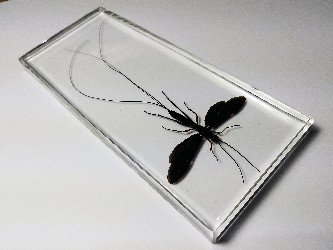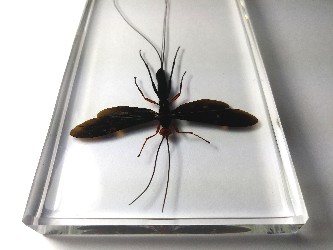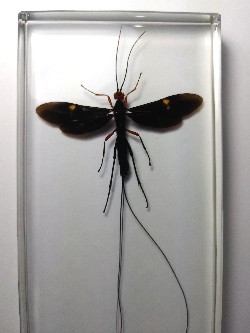











BRACONIDAE PARASITOID WASP Embedded in clear epoxy resin |
 |
 |
 |
 |
 |
 |
 |
 |
 |
 |
 |
 |
|
Classification & biology of Braconid wasps  CLICK FOR DOWNLOAD --------------------------------- Classification Phylum Arthropoda Class Insecta Order Hymenoptera Superfamily Ichneumonoidea Family Braconidae
.............................. Braconinae parasitoids emerged from larvae of Lobesia botrana (PDF)
CLICK FOR DOWNLOAD |
BRACONIDAE PARASITOID WASP The Braconidae are a family of parasitoid wasps. After the closely related Ichneumonidae, braconids make up the second-largest family in the order Hymenoptera, with about 17,000 recognized species and many thousands more undescribed. One analysis estimated a total between 30,000 and 50,000, and another provided a narrower estimate between 42,000 and 43,000 species. The Braconidae are currently divided into about 47 subfamilies and over 1000 genera, which include Aerophilus, Aleiodes, Apanteles, Asobara, Bracon, Cenocoelius, Chaenusa, Chorebus, Cotesia, Dacnusa, Diachasma, Microgaster, Opius, Parapanteles, Phaenocarpa, Spathius, and Syntretus. The morphological variation among braconids is notable. They are often black-brown (sometimes with reddish markings), though some species exhibit striking coloration and patterns, being parts of Mullerian mimicry complexes. They have one or no recurrent veins, unlike other members of the other family in Ichneumonoidea (Ichneumonidae), which usually have two. Wing venation patterns are also divergent to apparent randomness. The antennae have 16 segments or more; the hind trochanters have two segments. Females often have long ovipositors, an organ that largely varies interspecifically. This variation is closely related to the host species upon which the wasp deposits its egg. Species that parasitize microlepidopterans, for instance, have longer ovipositors, presumably to reach the caterpillar through layers of plant tissue. Some wasps also have long ovipositors to bypass caterpillar defense mechanisms such as spines or hairs, or to reach deeply-burrowed Coleoptera larvae in tree trunks. Endoparasitoid species often display elaborate physiological adaptations to enhance larval survival within the host, such as the co-option of endosymbiotic viruses for compromising host immune defenses. These bracoviruses are often used by the wasps instead of, or in addition to, a venom cocktail. The DNA of the wasp actually contains portions that are the templates for the components of the viral particles and they are assembled in an organ in the female's abdomen known as the calyx. A 2009 study has traced the origins of these templates to a 100-million-year-old viral infection whose alterations to its host DNA provided the necessary basis for these virus-like "templates". These viruses suppress the immune system and allow the parasitoid to grow inside the host undetected. The exact function and evolutionary history of these viruses are unknown. Sequences of polydnavirus genes show the possibility that venom-like proteins are expressed inside the host caterpillar. Through the evolutionary history of being used by the wasps, these viruses apparently have become so modified, they appear unlike any other known viruses today. Because of this highly modified system of host immunosuppression, a high level of parasitoid-host specificity is not surprising. The species Microplitis croceipes possesses an extremely accurate sense of smell and can be trained for use in narcotics and explosives detection. At least some braconids appear to be very resistant to ionizing radiation. While a dose of 400 to 1000 rads can kill an average human, a dose of 180,000 rads was required to kill a braconid of genus Habrobracon in an experiment.
|